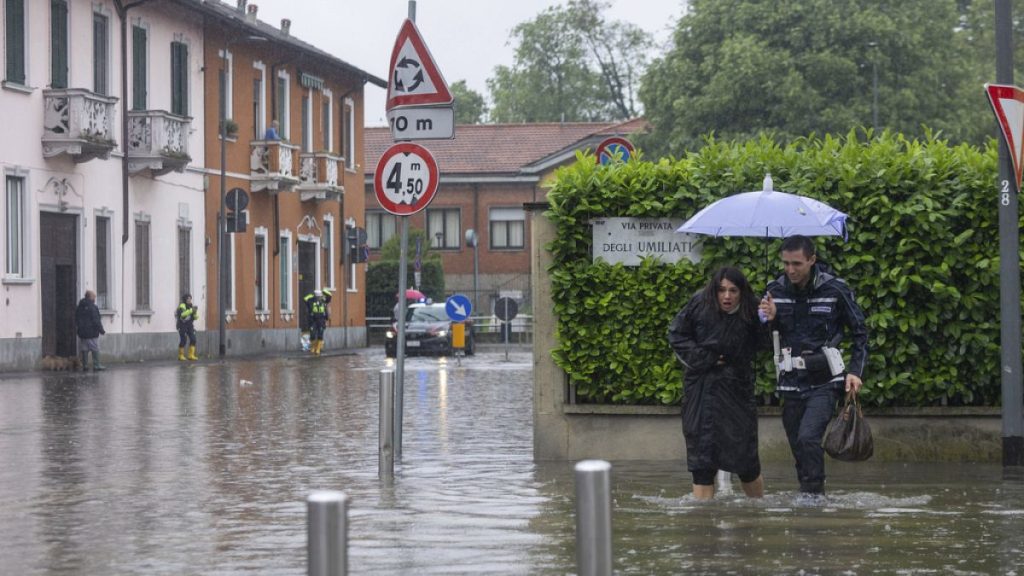Heavy rain has caused widespread disruption and damage in Milan, with the courthouse being flooded as a result. The severe storm that hit Rome last Tuesday also damaged the famous Arch of Constantine, and another wave of bad weather has hit northern Italy, leading to damage and traffic disruption. In Milan, a violent storm has caused widespread flooding and traffic jams, with part of the courthouse underwater and efforts underway to contain water leaking from the roof. Although there is no immediate danger for the Lambro and Seveso rivers, Milan’s security councillor Marco Granelli has warned that the storms will last all day and may get worse.
The situation is particularly severe in Piedmont, where the Stura di Lanzo river has exceeded the danger level in Mezzenile and reached the warning level in Lanzo. Heavy rain has hit the Turin valleys, with some areas receiving 169mm of rain in the last 12 hours. Several rivers in the region are nearing warning levels. Aosta Valley has also been affected by heavy rain, leading to closures of roads to towns like Cogne, Valnontey, and Lillaz. In Liguria, the rain is slowly decreasing after an orange alert, with the rain moving towards the center of the region. The Civil Protection Authority has confirmed the reopening of the A10 motorway and the resumption of rail services between Finale Ligure and Loano.
The Italian Society of Environmental Medicine has reported that Italy has experienced 878 extreme weather events in the last three years, with 310 in 2022, 378 in 2023 (a 22% increase from the previous year), and 190 so far in 2024. This data highlights the increasing frequency of extreme weather events in Italy and underscores the need for improved preparedness and response measures. The impact of these events is evident in the widespread disruption and damage caused by recent storms in various parts of the country. With continued unpredictability and severity of weather patterns, it is essential for authorities and communities to strengthen their resilience and adaptation strategies to mitigate the risks associated with extreme weather events.
As climate change continues to affect weather patterns globally, Italy is facing increasing challenges from extreme weather events, including heavy rain, flooding, and storms. The recent floods in Milan and other parts of northern Italy are a stark reminder of the need for proactive measures to address the impacts of climate change. The damage and disruption caused by these events have significant economic, social, and environmental consequences, underscoring the importance of building resilience and adaptive capacity at all levels of society. By investing in sustainable infrastructure, early warning systems, and community-based preparedness initiatives, Italy can better respond to the growing threat of extreme weather events and protect vulnerable populations and critical infrastructure.
In light of the increasing frequency and intensity of extreme weather events in Italy, urgent action is needed to address the underlying causes of climate change and reduce the risk of future disasters. This will require a coordinated and comprehensive approach that involves government agencies, local authorities, businesses, and communities working together to develop sustainable solutions. By promoting renewable energy sources, reducing greenhouse gas emissions, and adopting climate-smart land use practices, Italy can play a key role in mitigating the impacts of climate change and building a more resilient and sustainable future. Through international cooperation and partnerships, Italy can also contribute to global efforts to address climate change and protect the planet for future generations.
The recent storms and floods in Milan and other parts of Italy serve as a wake-up call for the need to prioritize climate action and build resilience to extreme weather events. With the number of extreme weather events on the rise and their impacts becoming more severe, Italy must take decisive steps to adapt to the changing climate and reduce its vulnerability to disasters. By investing in climate-resilient infrastructure, improving early warning systems, and strengthening disaster preparedness and response capabilities, Italy can better protect its population and resources from the increasing risks posed by extreme weather events. Through proactive and coordinated efforts, Italy can lead the way in building a more sustainable and secure future for its citizens and the planet as a whole.


